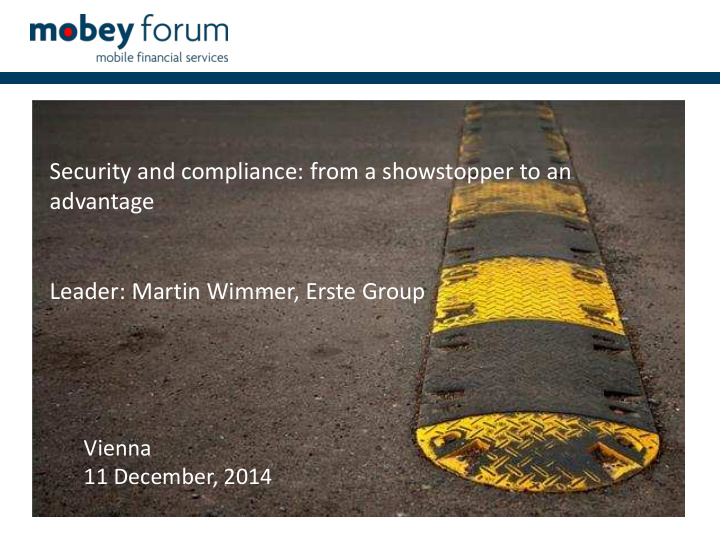



Security and compliance: from a showstopper to an advantage Leader: Martin Wimmer, Erste Group Vienna 11 December, 2014
Challenges • EU Regulation – MIF, PSD2 (esp. Account info, payment initiation) – How will third party providers act on „ our “ infrastructure with regard to authentication, security, ris, • PCI DSS, standards, certifications • Card schemes regulations • Future of authentication („strong authentication “, biometrics, tokens …) • Mobile (payments) security – Secure Elements (SIM centric, eSE , Cloud…) – Tokenization – remote vs. proximity – convergence of payments – Handset security – … • Financial inclusion • Data protection issues • …
How to overcome the threats / Ideas to make threats to opportunities • Regulation will probably lead to more electronic payments – how can we benefit? • Cross selling opportunities (includes mobile marketing/selling via beacon technology)? • Big data opportunities? • Extend our scope and card usage – e.g. with transit applications (via paywaye &/or paypass) • Future of online credit transfers? European wide.. • Financial inclusion opportunities (e.g. prepaid, other banking products)? • Own European wide card scheme Co-badged with a int. Scheme for usage abroad
The most thought-provoking/ surprising / “ ahaa- ” idea • A bank can become a Third party provider using the PSD2 „ opportunity “ to get account info and initiate payments from other bank competitors – But under a neutral name and not the bank name. E.g. PayPal is seen by the customers as neutral company, which is their brand core/positioning • Own European wide card scheme Co-badged with a int. Scheme for usage abroad
Summary I • Banking = TRUST and this is a main difference to Facebook, Google and others so we need to act more solid and serious with all pros and cons – Data protection – Regulation etc. • PSD2 - (esp. Account info, payment initiation) – How will third party providers act on and with „ our “ infrastructure with regard to authentication, security, risk etc. – unknown • Convenience and user experience are key for the user (see PayPal respectively other User Name & PW-solutions or Touch ID from Apple BUT will it continue with PSD2) – maybe yes, when somebody (the bank) takes the risk
Summary II • Future Authentication methods (e.g. 2 factor like PW and Card reader or Biometrics) depends on the Risk Management resp. Limit Management and can be seen as competitive advantage between banks • Authentication methods have to be fast & mobile (e.g. Card readers are not perfect for the mobile world but ok for the desktop PC but world goes mobile) • Embedded SE (using TEE) can also be used to make the phn more secure for authentication also and not „ only “ for payments • Cross selling of bank products in netbanking and mobile banking apps – we should use bank data much more as we do it today (our DATA and not BIG DATA)
Summary III • Mobile Marketing – cooperation models between the bank with partners to enter the mobile marketing area (can bring additional revenues for the bank) – Example netbanking: we have logos from retailers etc. e.g. in George – we could integrate partner apps in netbanking/George and negotiate with the main merchants for a reward structure for our clients or a supermarket to enable time saving pre-packaging etcetc. NETBANKING can be a „MARKETPLACE“/PORTAL TO PARTNER APPS/WEBSITES THE MORE CONNECTED THE CLIENT IS WITH THE BANK AND OUR PARTNERS THE LOWER IS THE PROBABILITY THAT THE CLIENT LEAVES OUR BANK (= CUSTOMER RETENTION)
Summary IV • Can we use the customer data? Not everywhere because of legal stuff but we can get the customer approval to use their data when we can promiss the 2 most relevant benefits which are – TIME SAVING for the client & – MONEY (reward, bonus, cash back, merchant coalition)
Recommend
More recommend